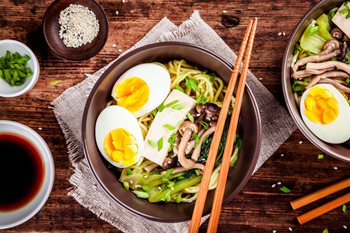
Every regional cuisine boasts some kind of noodles and dumplings: Russians have their pelmeni, Italians their ravioli, and Iraqis their kubbeh. But in Asia, where these staples have been traced back more than two thousand years, both noodles and dumplings are important cultural symbols.
Noodle history is almost as old as the history of mankind. Long strands of pasta in Asia represent longevity and are served at birthday celebrations just as candles are put in Western birthday cakes. They can also represent a journey and are often offered to a guest arriving from a long trip, or setting out on one.
Crescent-shaped dumplings resembling gold and silver ingots — the currency of ancient China — symbolize wealth and are an integral part of any New Year’s celebration. They also symbolize family unity and togetherness, not only because of their round shape but also because making dumplings is a long, drawn-out process involving repetition, and thus made easier and more enjoyable as a group activity.
Any trip to Asia offers a golden opportunity to learn more about these ancient and highly symbolic staples of the continent’s diverse and magnificent cuisines. To help you sort your potstickers from your wontons, here are just a few of the most popular forms of both dumplings and noodles!
Dumplings:
Steamed Dumplings
Shao mai – These are the dumplings you are used to getting with your Chinese takeaway with their signature white skins and assorted fillings.
Xiaolong bao – These dumplings are stuffed with a collagen-rich pork mixture that becomes solid as the mixture cools. When heated, the mixture turns liquid inside the dumpling for a burst of flavor. Crab and pork are favorite flavor pairings in the fillings.
Zheng Jiao - These delicately pleated dumplings are steamed in a bamboo basket. Their transparent wrappers show their fillings, amongst which shrimp, pork, cabbage, and mixed vegetables are the most common.
Boiled Dumplings
Shui jiao – literally 'boiled dumpling,' these delectable nuggets are wrapped in a thin, wheat-based wrapper. They can be served in soup or with a dipping sauce.
Hun-tun – Known as “wonton” in Cantonese, these are the dumpling most associated with the egg noodle soup. Shrimp is often the filling or a spicy mix of pork and watercress.
Tang jiao are dumplings served in broth.
Fried Dumplings
Guo tie – these are the crescent-shaped dumplings known as “potstickers” in America. The chewy skin is fried quickly in hot oil for a crunchy texture. Fillings can vary.
Fried wonton – deep-fried wontons are served as an appetizer, with spicy or sweet and sour dipping sauces.
Noodles
Ramen — Ramen noodles are so much more than cheap midnight fodder for college students. Made from wheat-based flour and egg, they are chewy and absorbent, often served with broth or thick sauce. A true ramen bowl is a delicate balance of flavors and textures with nary a flavor packet in sight.
Soba — refers to any thin Japanese noodle, but the most common are made from buckwheat flour, which makes them popular with the gluten-free crowd. Buckwheat’s many health benefits make soba noodles a popular base in Western health food restaurants for noodle/grain bowls or chilled noodle and vegetable salads.
Udon — wheat-based udon noodles are thick, chewy and very satisfying! They are most often encountered swimming in bowls of spicy broth topped with shredded meat, chopped vegetables, and spicy oil.
Rice noodles — come in varying sizes from thin vermicelli to wide rice noodles. They are more delicate than their wheat-based counterparts, but easier to cook since they require only a short soak in hot water to activate. Rice noodles are often added to stir-fry, pad thai, pho, Banh-mi, and other Asian noodle dishes.
Glass or “cellophane” noodles — are often confused with rice noodles, but glass noodles remain transparent even after they are cooked, while rice noodles turn translucent after cooking. Glass noodles are made from a range of starches such as mung beans, cassava, or potatoes. They are used in soups, hot pots, and spring rolls. In Japan, glass noodles are called harusame or “spring rain.”
Alexander + Roberts offers an extensive menu of travel options to Asia including our popular
Beijing + Xian + Shanghai China Tour, a private 8-day journey with our experienced local guides and private car and driver. Star planning your trip to China today!